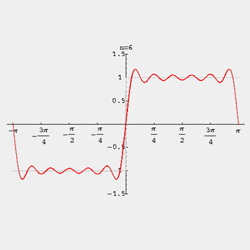
Question posted by Dave T.
How much do modern a/d d/a convertors still suffer from pre-ringing ?
Has it been eliminated or drastically reduced in modern convertors ?
If you drop more money on convertors do you necessarily get a better result, or, is pre-ringing simply a “fact” of digital audio that simply does not exist in analog ?
‘Just trying to understand this particular issue.
Reply by John Roberts {JR}
Google “Gibbs phenomenon”…
Reply by cgc
The classic Gibbs example is a square wave at full scale and close to one half the sampling frequency. Are you recording a lot of stuff like that? I think most of the filters used in converters handle all but the most extreme cases very well.
It comes more into play for image processing and FFT based lossy compression like MP3 where pre-echo can be a problem.
A previous discussion on R/E/P discusses this in great detail.
Bruno knows a lot about this and can explain how it affects the real world better.
An Excerpt From The Previous Discussion
A question from George_
I talked to Daniel Weiss today and he says that the Gibbs Phenomenon only make problems in “certain” FIR-designs..
I have to admit, that it’s too long ago where I took math.. and I missed that in my physics-studies…
is there any way you can explain this to a well physics-educated (nuclear and alternative energy as main topics) guy, but with a lot of math-problems these days? Very Happy Very Happy
and while you are talking to me.. I still don’t get it, why my ITB-mix collapses with too much transients, and my hardware doesn’t.. Very Happy but maybe that is a problem for another time-domain Very Happy
Reply by John Roberts {JR}
It’s hard to get excited about .1 dB but Gibbs is pretty well described in sundry places
Here are some great resources:
Wikipedia and S.O.S Mathematics
Reply by bruno putzeys
The term “gibbs phenomenon” relates to ripple effects both in the time and frequency domain.
When a time-domain response is truncated (as is necessarily the case if you want a finite number of taps), the frequency response will show ripples. When a frequency-domain response is truncated (as happens in a sharp low-pass filter) the time domain response will show ripples.
The inband ripple is almost a red herring in this context. Yes, inband ripple could drive a filter into overload if fed a full-scale steady-state sine wave at one of the peaks that just exceed 0dB. This is not going to happen with normal program (although I believe there’s one record by Yoko Ono that could pull it off).
The one you’re bumping into is the time domain ripple. As soon as a low-pass filter cuts off sharper than a pure gaussian, its impulse response will have ringing (at least 1 excursion of the opposite sign of the main lobe) and you can create an intersample over by feeding it a full scale string of minimum and maximum samples to coincide with the sign of the coefficients of the filter. Any filter steeper than a gaussian filter is prone to intersample overs.
A more intuitive (and no less accurate) way of seeing it is by looking at the reconstructed waveform. It is very unlikely for any audio signal to peak exactly at a sampling instant. Most of the time, the absolute peaks are located somewhere in-between samples. This means that all samples would have values lower than the peak. If a limiter boosts the signal so that the actual samples hit the ceiling, the peak will be over 0dBfs and get clipped.
This means that even the “modest perfectest” FIR LPF will cause intersample overs, and they won’t be related to the ripple in the frequency response.
